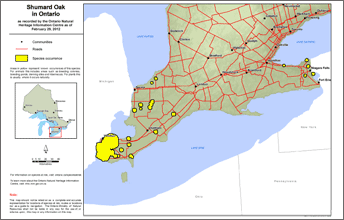Shumard oak (Species at Risk)
Scientific name: Quercus shumardii


Cover photos credit: Allen Woodliffe (all photos)
Status
Special Concern
“Special Concern” means the species lives in the wild in Ontario, is not endangered or threatened, but may become threatened or endangered due to a combination of biological characteristics and identified threats.
Date added to the Species at Risk in Ontario List
The Shumard oak was already assessed as a species of special concern when the Endangered Species Act took effect in 2008.
What it looks like
The Shumard oak is a tall tree which can grow to a height of 40 metres with massive branches. The bark of this tree is grey-brown to dark brown and shallowly fissured. The leaves are shiny above with five to nine deep lobes, each lobe having several large conspicuous teeth or smaller lobes. The fruit is an acorn, with a 14 to 30 millimetre long nut in a light-brown to reddish-brown flatly saucer-shaped cup.
Where it lives
Shumard oaks prefer moist soils, and can grow close to water and in swampy areas. It typically grows in deciduous forest or along fencerows.
Where it’s been found in Ontario
The Shumard oak is found primarily in the south-central United States, from Indiana and Ohio west to Kansas, Oklahoma and Texas, south to the Gulf coast and northern Florida, and east to North Carolina. Separate populations are found in Pennsylvania and Maryland. In Ontario, it grows in Essex, Kent, Elgin and Lambton counties in the southwestern part of the province, and in the Niagara Regional Municipality.
View a larger version of this map (PDF)
What threatens it
Trees in fencerows are at risk from fencerow brushing and field clearing. Large forest trees may be taken for logging. Shumard oak occurs in counties that have lost most of their forest cover, which is habitat for this tree species.
Action we are taking
Special concern species do not receive species or habitat protection.
Management plan
A management plan advises the ministry on ways to ensure healthy numbers of the species return to Ontario.
Read the management plan (June 28, 2013).
Government response statement
A government response statement outlines the actions the government intends to take or support to help recover the species.
Read the government response statement (March 7, 2014).
What you can do
Report a Sighting
The Ministry of Natural Resources and Forestry tracks species at risk. You can use a handy online form to report your sightings to the Natural Heritage Information Centre. Photographs with specific locations or mapping coordinates are always helpful.
Volunteer
Volunteer with your local nature club or provincial park to participate in surveys or stewardship work focused on species at risk.
Be a good steward
- private land owners have a very important role to play in species recovery; you may be eligible for stewardship programs that support the protection and recovery of species at risk and their habitats
- the Carolinian forests of southern Ontario support an amazing diversity of plants and wildlife, including many species at risk; Carolinian Canada is working to help recover species at risk and their habitats; for more information, visit: www.carolinian.org/SpeciesHabitats.htm
Report illegal activity
Report any illegal activity related to plants and wildlife to
Quick facts
- the Shumard oak’s shiny, deep-lobed leaves help distinguish the species from the similar-looking Red oak
- Shumard oaks hold their leaves longer into the fall than other oaks
- in the southern United States where the tree is much more common, the Shumard oak is an important source of food for songbirds, wild turkeys, waterfowl, white-tailed deer, and squirrels; its wood is used commercially for cabinets, furniture, floors, and lumber
